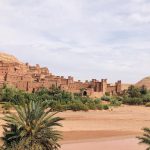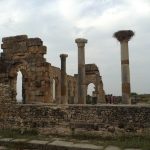The whole year-round can be a good time to visit Morocco, depending on what you want to see and do during your trip. Generally, the best time to visit the country is in spring, between April and May as the weather is warm and dry around most of the country.
The weather also becomes very lovely in the fall (September to October) when the temperatures are not so hot. This is especially noticeable when visiting Merzouga and the Sahara desert. The high Atlas Mountains can also be visited all year round, although it does get cold in winter. The summer may still be a bit hot to embark on any long-distance hikes, but if the heat doesn’t bother you then conditions are fine any time between April and October. Outside these months, there is snow on the peaks, which makes hiking more dangerous, but creates some spectacular panoramas.
Each year, millions of people from around the world visit Morocco to experience its unique sights, tastes and sounds, the smells of chicken tagine and Moroccan spices waft through ancient open-air souks in Marrakech, while hikers and climbers escape to the snow-capped peaks of the High Atlas mountains. Men gather on street corners each afternoon, sipping sweet green tea as the daily call to prayer beckons, a reminder of their deeply rooted culture and traditions.
To sum up, depending on what you’d like to do, Morocco can be visited at any time of the year.
January and February :
If your home is buried in snow and ice in January/February, a Moroccan vacation may be a much needed welcome.
The weather in January/February tends to be chilly in the mornings, then warming up in the middle of the day, then becoming chilly in the evenings. If there’s no sun it will remain cold all day long, but the cooler temperatures make it more comfortable for those who wish to explore the warmer areas of the country. If you’ve always wanted to see the Sahara Desert, January is the time to do it. If you want to spend hours losing yourself in the sights and sounds of the Marrakech Medina, you’ll do it more comfortably in these months.
When visiting this time of year, the first thing to remember is that the temperature in Morocco in January can vary a LOT. When the sun is out during the day, it can feel quite warm at times. But at night, temperatures can drop very low. Add to that, the varying landscape of the country.
March and April :
March marks the beginning of springtime in Morocco. The temperature in Morocco in March grow warmer during the day, depending on the area of the country you visit, nights are still cold. Spring continues to blossom in Morocco in April, the days will be longer and warmer and the nights will be that beautiful warm weather feeling that’s got just a touch of breeze in the air. Add to that, the rain brings Morocco’s landscapes to life. Especially in the second half of March and into April, you’ll enjoy vibrant green almost everywhere you go.
You’ll get a mix of warm days and cool nights, you can travel to any part of the country, desert and mountain, without worrying about freezing or burning your butt cheeks off,
And, if you really want to ride that camel in the desert with a turban on your head, you can! You can go anywhere, and enjoy so much of the country if you plan to stay during these two months. No limits, no worries.
May and June :
In May, it gradually starts getting hotter and sunnier, so it’s time to take out your summer clothes, the days get much warmer in May in Morocco in inland cities such as Marrakesh & Fez. Along the Mediterranean coast, the ocean breeze keeps things a bit cooler. The farther into the desert you get, the higher the daytime temperatures will be. Some places can be uncomfortably hot, especially for those sensitive to heat. On the other hand, a visit to the Atlas Mountains in May will feel downright refreshing.
Generally, May is very green with field crops thriving usually and poppies around the place as well.
June is when it’s starting to warm-up significantly in many areas, especially the south and inland areas, Along the Mediterranean and Atlantic coastlines the weather tend to be cool. But inland, the temperatures go up quite a lot, but despite that, although once the sun goes down, things cool off and become much more pleasant.
On the other side, June marks the beginning of Morocco’s dry season, don’t forget to keep water with you due it’s the best way to make sure you stay well-hydrated.
July and August:
July and August are the two hottest months of the year in Morocco, they are the least ideal months to travel to Morocco but they shouldn’t be ruled out. It’s the perfect excuse to spend the afternoon cooling off by the pool. On the good side, Temperatures are more bearable along the Atlantic and Mediterranean coastlines and the High Atlas mountains. But while in the inland areas, be prepared for days to be hot and very dry.
September and October :
Wow! Didn’t Our Summer Go Fast!! Morocco’s summer peak heat is subsiding in September and the autumn slowly arrives. The temperatures cool off quite a bit long the coastline even in the Atlas mountains, so you can enjoy many different activities without worrying about the weather, But the desert regions still retain a fair amount of heat, so perhaps it’s worth another month’s wait to ride a camel to a desert camp.
In October, you definitely start feeling the shift from summer to Autumn with dropping temperatures. It is still quite warm during the day, which is the perfect time to visit morocco. In the mountains, temperatures drop even more. And if you are staying on the coast, you may feel at times that the heat of the sun is in direct competition with the chill of the ocean breeze. Please note, that after the dry hot summer, the rain starts to increases at times.
So if you dream of a vacation in September/October, Morocco is ready to welcome you!
November and December :
Late fall and early winter in Morocco is sunny and mild, it’s the perfect time to explore the coast to the mountains to the desert, such an amazing adventure waiting for you! In November all around the morocco, temperatures continue to drop, and it is usually one of the months where it rains the most in the country, I would only say November is another fantastic period to visit the city.
December’s weather is still wonderful in Morocco, with most of its cities and port towns experiencing warm daytime temperatures and hours of glorious sunshine. But it can get cold when sundown.
Generally Morocco’s weather in December is cool, mild and somewhat rainy, but it also brings many sunny days ideal for hiking and exploring the cities.
the Mediterranean coast will be lovely and warm during the daytime (but it can turn chilly at night). The climate in the Sahara is at its most extreme; hot and dry but after dark, you’ll need to bundle up.












